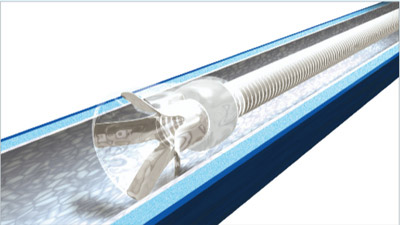UC San Diego Among Multidisciplinary Awards Providing $221M Nationally for Cutting-Edge Projects
Technology & Engineering
When a large blood clot was discovered attached to the end of a catheter inside the right atrial chamber of a patient’s heart, doctors faced a daunting challenge. If the clot came loose, the consequences would likely be catastrophic for the patient, who suffered from pulmonary hypertension – a dangerous narrowing of blood vessels connecting the heart and lungs.
But experts at the UC San Diego Sulpizio Cardiovascular Center (SCVC) are now able to save patients like this one from potentially fatal outcomes by using a new technology capable of removing blood clots, infected masses or foreign bodies from major cardiac blood vessels without performing open-heart surgery.

New catheter-based device used to remove blood clots, infected masses or foreign bodies from major cardiac blood vessels.
The SCVC is the first in San Diego County to use the AngioVac system developed by AngioDynamics. The AngioVac is a catheter-based device in which thin tubes are inserted into two major veins in the body through the neck or groin area. Under X-ray guidance, the flexible tubes are advanced to the proximal veins, right-sided heart chambers and/or lung arteries. Each is equipped with an expandable, balloon-shaped funnel tip that, when attached to a bypass circuit, vacuums the targeted material, such as a blood, clot out of the body.
“In some cases, medications can be used to dissolve blood clots, but this treatment option does not work for all patients, especially those who are in a life-threatening situation,” said Mitul Patel, MD, FACC, interventional cardiologist at UC San Diego Health System. “This new device allows our team to safely extract material, preventing the patient from having to undergo invasive, high-risk surgery.”
Open-heart surgery takes much longer to perform and often requires the surgeon to divide the breastbone lengthwise down the middle and spread the halves apart to access the heart. After the heart is repaired, surgeons use wires to hold the breastbone and ribs in place as they heal.
"Removing a blood clot through open-heart surgery results in longer hospitalization, recovery and rehabilitation times compared to the minimally invasive approach provided by this new device," said Victor Pretorius, MBchB, cardiothoracic surgeon at UC San Diego Health System.
The AngioDynamics device does not eliminate the need for a surgery called pulmonary thromboendarterectomy (PTE) to remove chronic blood clots in the lung arteries, a surgery that cardiothoracic surgeons at UC San Diego Health System have special expertise in performing.
Nearly 100,000 Americans die each year when a clot breaks away from a blood vessel wall and lodges in the lungs or heart. Several factors can cause a blood clot, including certain medications (oral contraceptives and hormone therapy drugs), deep vein thrombosis, family history, heart arrhythmias, obesity, surgery, prolonged sitting or bed rest, and smoking.
The new procedure is performed by a multidisciplinary team comprised of anesthesiologists, cardiothoracic surgeons and interventional cardiologists. Six patients at UC San Diego Health System have undergone the procedure so far, which can be completed in as little as one hour with patients typically able to walk and leave the hospital the following day.
"The success of this new device would not be possible without the collaboration of our colleagues dedicated to helping patients with a vast array of cardiovascular issues,” said Patel. “As the only academic hospital in San Diego County, we are excited about this new technology and what it offers as a new treatment option for our patients at SCVC.”
To learn more about treatment options at UC San Diego Sulpizio Cardiovascular Center, click here.
Keep up with all the latest from UC San Diego. Subscribe to the newsletter today.